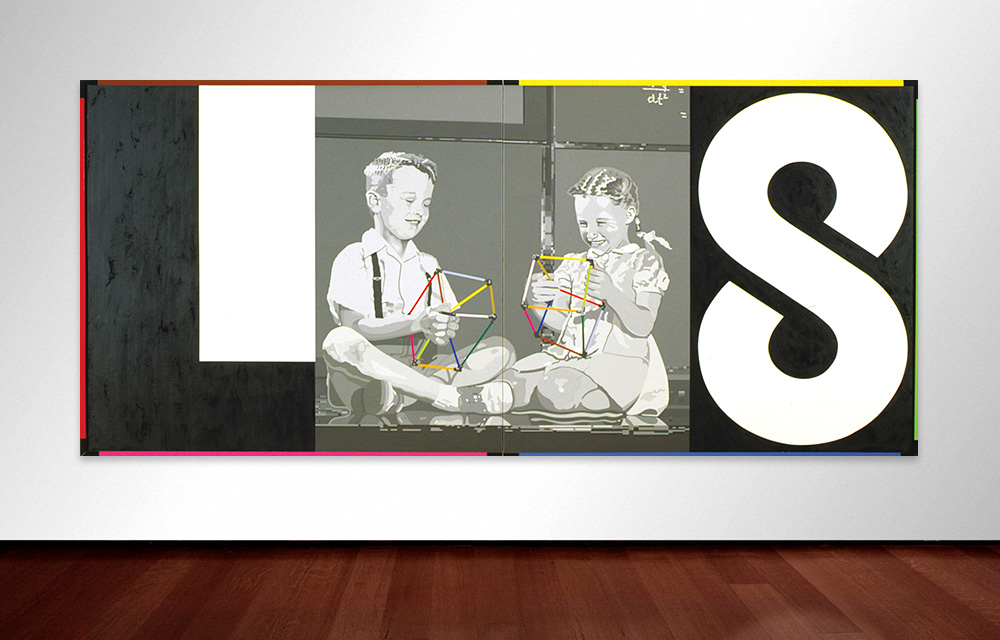


Peter Tyndall's reputation rests in part on his inventive pictorial imagination, the conceptual toughness of his works, and the obsessive professionalism of their physical execution and presentation. As in the Pop Art tradition, his work often utilises imagery from the print media, including advertisements, newspaper photography and cartoons. But unlike most recent 'Popists', Tyndall processes his images via a meticulous hand-painting in oils. This leads to a sensuous, indeed savourous execution, which, despite Tyndall’s chastening subjects, is one of the sources of enjoyment in his art. His work reflects on the process of looking at images as culturally encoded, and as conditioned by the context of their display. A distinctive element is the autobiographical nature of Tyndall's thinking on issues such as his memories of the mass media as a boy, or the way his sense of self has been transfigured by his Catholic upbringing. In recent years his sense of religiosity has moved him towards Buddhism.
Both paintings in the Vizard Foundation Collection adopt the five-part format Tyndall has used since 1988. They read from left to right, and employ the five letters of the Greek word 'LOGOS'—'the divine Word that speaks the universe into being.'1 Only the black letter 'L' and the white letter 'S' are visible here. Tyndall adopted this format after a visit to the Vatican in 1988, where in the crypt of St Peter's he studied a late Roman amulet in beaten gold showing two doleful eyes separated by a cross: an amulet designed to deflect the Evil Eye.2 In his five-letter paintings, the amulet eyes (or their substitutes) became the 'Os' of LOGOS, and the cross the central 'G'. More generally, these pictures suggest how language itself enframes all of our perceptions and structures our experience.
In the first picture, the minds of children develop in accordance with the Word. Derived from a photograph from a late 1940s magazine, two school children laugh as they manipulate a new educational toy made, Tyndall says, by the inventor of molecular models. Tyndall has rendered the black-and-white photo in oils: a sombre touch vitalised by the brilliant colours used for the stick models, colours taken up in the exterior timber frame of the picture. The play between the coloured frame and the interior toys suggests analogies between the child's formative model of experience and ways of considering art on a gallery wall. That is, art is framed and limited as a system of meaning, and supported by the invisible network of art world/audience relations. This idea is encapsulated in the generic title of all Tyndall's works: detail. A Person Looks At A Work of Art/someone looks at something ...
The second work was produced for the artist's large exhibition Dreaming Bendigo into being, a homage to his home town of Bendigo in country Victoria. This painting offers a meditation on the artist's personal history as a child growing up there. At the same time it is an allegory of white, Christian culture's 'triumph' over the vanquished Aboriginal Dja Dja Wrung people at the time of the Bendigo gold rush. To read the artist's five-page brochure on the exhibition is to be initiated into the complex mind-ways of this 'supremely intelligent bush philosopher'.3
In the central section of the work, the black square of the first 'O' derives from a photo of the artist at the age of one examining a cube, taken by one Reg V Brock at the View Point Studio in central Bendigo. It marks Tyndall's personal connection to Charing Cross, the town's central intersection, which he represents schematically in the next logo to the right. The eccentric shape of this cross derives from an old street-plan of Bendigo, where the Alexandra Fountain covers the old ‘Bednego’ Creek. Charing Cross symbolises the European presence, the order of rationality superimposed over the free-flowing curve of the river beneath, now 'robbed of its gold, walled up and cast into darkness' (Tyndall). Other salient features are the ideogram familiar from the artist's 1970s and 1980s work—the frame of a painting, suspended by black lines suggesting its cultural context—and the circle of twelve dots that symbolise Tyndall's 'chemist father with the "binary bicycle" on which he went to work'.4 In the Bendigo installation, twelve old chopping-blocks borrowed from friends, family and locals arrayed in a circle were offered as altars to the memory of domestic work.
Peter Tyndall's post-conceptual painting marries personal emotion and semi-private meaning with a great clarity of conception. This is the result of taking his own dreams seriously, and doing a remarkable amount of planning and hard work to achieve the impact of a simple graphic statement. Bound into Tyndall's fecund, quasi-rational analogising is a sense of whimsy that is the heart of art as he understands it.
- Roger Benjamin
Peter Tyndall is represented in Australia by Anna Schwartz Gallery, Melbourne and Sydney.